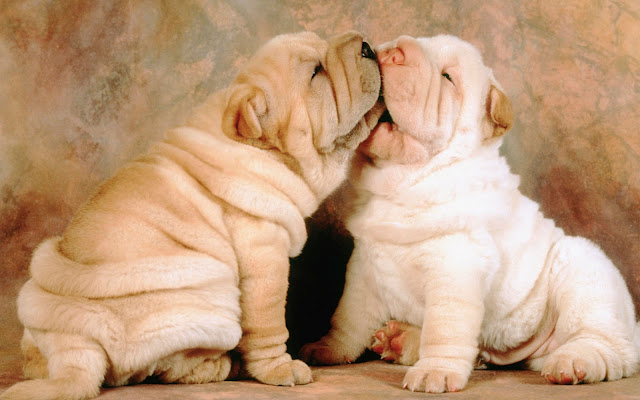The Chinese Shar-Pei is also known as: Chinese Fighting Dog
Fast Facts
Group classification: Non-Sporting Country of origin: China Date of origin: Antiquity
Weight (M): 50 - 60 lb Height (M): 19 - 20" Life expectancy: 9 - 10 years
Weight (F): 45 - 50 lb Height (F): 18 - 19"
1.General Description of the Chinese Shar-Pei
A unique and intelligent dog that most often is recognized for its wrinkles, the Chinese Shar-Pei initially was developed as an all-purpose Chinese farm dog: a medium sized, square and compact dog, close coupled with a large yet handsome head. The Chinese Shar-Pei has a unique look all their own, wrinkled loose skin — with a short bristled coat — that covers the body and head, small ears, a “hippopotamus” muzzle, and a high set tail. The dog’s wrinkles are more pronounced in a puppy than in an adult. Shar-Pei commonly have two coat types, either “horse,” short; or “brush,” up to an inch long. A third rare coat-type, which is not recognized by the AKC, is the “bear” that is longer than one-inch. The large head has dark, small, sunken, almond-shaped eyes that lend a scowling expression; the extremely small ears lie flat on the skull and are set high and forward; the muzzle sports a large and wide nose, and a blue-black tongue. The coat can be of any solid color, and is absolutely straight and off-standing on the main trunk of the body but generally lies flat on the limbs.
2.Chinese Shar-Pei Temperament
The Chinese Shar-Pei takes itself seriously, and demands that others do likewise. The dog’s ever present scowl is indicative of its attitude toward strangers or anything else it sees as a threat to its family, including other dogs. This is not to say the dog cannot be socialized – quite the contrary, in fact – but its first instinct toward outsiders is definitely suspicion. Once the newcomer has been brought into the fold, however, he will have a proud, loyal and devoted friend. The Shar-Pei’s independent nature can make training a chore, as the dog is unlikely to obey anyone it sees as weak or not in control. Though not a particularly playful breed, the Shar-Pei gets along well with children and other pets. Take care when training your Shar-Pei that it does not become antisocial or too much of an “alpha dog.”
3.Caring for a Chinese Shar-Pei
Training a Shar-Pei requires a firm hand and plenty of patience. Establish dominance over the dog, and do not let it display aggressive behavior in front of strangers, pets or children. Make sure the dog is thoroughly socialized as a puppy with other dogs to avoid problems in adulthood. As a working breed, the Chinese Shar-Pei needs plenty of exercise, and should have an opportunity every day to go on a long walk or play off the leash in a dog-friendly park. The most common health conditions seen in the breed are fever, amyloidosis, canine hip dysplasia and eye entropion; other concerns include patellar luxation, hypothyroidism, allergies and skin fold pyodermas.



















